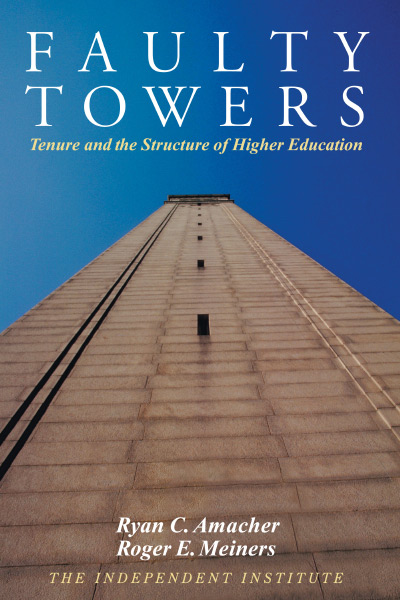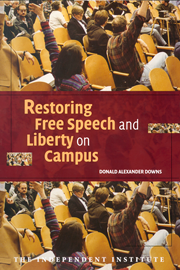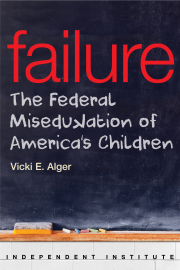| Formats |
Paperback |
eBook |
| Formats |
Paperback |
eBook |
Overview
As debate accelerates over the declining standards in higher education, academic tenure is viewed with suspicion by many, who see it merely as job protection for incompetent teachers. Even many professors believe tenure is a guarantee of lifelong entitlement, whereby only the commission of a crime can lead to dismissal. Faulty Towers sets the record straight by elucidating the history, legal status, and common misunderstandings regarding tenure.
Tenured professors who have become incompetent are rarely dismissed, and superior teaching is rarely rewarded, although there is little to prevent universities from doing so. Tough administrators are also hard to find—in part because university trustees seldom hold them accountable. Faulty Towers explains how restructuring university incentives to be more in line with those of market-based enterprises would produce greater accountability, stronger boards of trustees, more effective administrators, and a tenure system that protects academic freedom but not substandard education.
Contents
-
Chapter 1. The Origins of Tenure
Chapter 2. The Legal Meaning of Tenure
Chapter 3. Roots of the Structural Problems in Higher Education
Chapter 4. Eating the Fixed Pie
Chapter 5. Managing Faculty as a Valued Resource
Chapter 6. Reforming Tenure or University Structure?
Chapter 7. Internal Reforms
Chapter 8. External Reforms
Chapter 9. Conclusion
Appendix
Notes
References
Index
About the Authors
Detailed Summary
- Academic tenure in American higher education has faced growing criticism since the late 1990s. Many believe that tenure lowers the quality of instruction. Unfortunately, too much emphasis has been placed on tenure at the expense of other institutional features of higher education. Improving colleges and universities requires addressing the totality of incentives facing trustees, administrators, and faculty. For example, real reform could include eliminating centralized university systems and state coordinating boards, allowing colleges in state university systems to set their own tuition, and ending the public subsidy to graduate education which produces an unneeded glut of underemployed people expecting above average incomes.
- Tenure was not created to redress a lack of academic freedom. Before modern tenure arrived in the early 20th century, few faculty were fired for their political views. When, in 1894, economics professor Richard Ely created a stir by publicly advocating labor strikes and boycotts, the board of regents of his university (University of Wisconsin) issued a strong defense of academic freedom. Ely, who did not have tenure as we know it today, was not touched. By 1900, the presidents of Harvard, Columbia, and Chicago all asserted that no donor would be allowed to interfere with the ideas espoused by university faculty.
- Modern tenure began in 1915 when a committee of the American Association of University Professors (AAUP) recommended that tenure be granted—on advisement of a faculty committee—after successful completion of a probationary period (then ten years, since 1940 usually seven). The aim was to raise the standards of faculty by avoiding nonproductive colleagues appointed by administrators who didn’t know or care about quality within a given discipline, not to protect faculty who become incompetent.
- Administrators, boards of trustees, and the public often mistakenly think that tenure grants faculty members rights that make them untouchable regardless of performance. But this is not the case. Tenure gives its holder not a lifetime job guarantee, but the right to procedural safeguards in case of termination due to claims of incompetence, dereliction of duties, moral turpitude, or financial crisis.
- From 1990 to early 2003, faculty who were dismissed for incompetence or dereliction of duties brought less than one lawsuit per year. Given the hundreds of thousands of tenured faculty members, if there were many dismissals, there would be more court cases with such cases heard of more often. Unsurprisingly, it is extraordinarily rare for a university to be ordered to reinstate a dismissed faculty member.
- The problem of unaccountable teachers has resulted from the politicization of colleges as government involvement has expanded. Universities should be decentralized to make all colleges independent (with separate boards of trustees), private and self-funded. The resulting competition and privatization would make administrators and faculty more accountable for school performance, reduce bureaucratic constraints schools face, give students more choices, improve competition among institutions of higher education and reduce college costs, and change stale curricula that often have not changed for decades because change is mired in status-quo committee and department standoffs.
- Rampant grade inflation is another manifestation of an irresponsible status quo. It demeans substantive accomplishment and is inexcusable. Stopping grade inflation is not difficult but requires changing the administrative structure of most universities so that trustees, administrators, and faculty are held accountable for school performance. Academic innovation would then directly follow such internal reform.
Higher education in America is the best in the world. Unlike our high schools, which compare poorly to other nations, American higher education puts Japan, France, and other countries with respected high school programs to shame. But to say that American higher education is generally better than government-monopolized higher education in other countries does not mean there is not room for improvement. As the auto industry and others have learned, the competition may catch up if you do not constantly work to improve.
In Faulty Towers: Tenure and the Structure of Higher Education, Ryan C. Amacher and Roger E. Meiners examine the internal and external reforms necessary to bring competitive forces to American universities and thereby improve them. Critics of American higher education have good reason to be disturbed by some of the foolishness and waste observed in colleges, but many critics focus solely on tenure. This is a mistake, Amacher and Meiners argue. That tenure appears to protect incompetent professors is merely a symptom of structural defects that limit greater efficiency and even more competition in higher education.
Tenure’s Origins and Legal Meaning
Before its modern incarnation early in the 20th century, tenure existed in the form of “presumptive permanence”; most faculty appointments were year to year, but it was rare for a college not to reappoint all members of the faculty. This changed after 1915, when a learned committee of the newly formed American Association of University Professors (AAUP) recommended tenure guidelines that became widely adopted over the next decade.
The committee’s goal was to ensure quality control. Members hoped to impose higher standards on their own institutions by forcing junior faculty to serve probationary periods rather than be granted tenure by the administration upon initial hiring. They did not intend to make tenure a lifetime sinecure or to protect professors who become incompetent in the classroom by failing to keep up on advances in their fields or by talking about their political views of the world instead of accounting or psychology.
Surprisingly, however, many college trustees and administrators do not understand that tenure does not significantly limit the ability of universities to demand quality performance over time. Although uncommon, tenured faculty who become incompetent, fail to perform their duties, or engage in misconduct are not saved by tenure, according to Amacher and Meiners, who exhaustively reviewed every reported tenure case in American courts from 1990 to 2003.
Tenure gives its holders, not a job for life, but procedural rights in the event that they are terminated for poor performance, misconduct, or financial exigency. Tenure typically confers 1) the right to appear in person at a hearing before a decision-making body, 2) the right to examine evidence and respond to accusations, and 3) the right to have advisory counsel present. Tenure is misunderstood and misapplied, but the fundamental incentive flaws in American academia are elsewhere.
Cracks in the Ivory Tower
The root of the problem facing institutions of higher learning is their non-profit status, Amacher and Meiners argue. As state institutions or charitable enterprises, American colleges and universities lack the discipline of the marketplace—as well as the helpful market signals provided by stock prices. Instead, top management and trustees in academia are guided by much lower quality measures of performance.
These deficiencies contribute to the poor accountability that plagues university governance. Unlike their corporate counterparts, university trustees face almost no chance of liability for bad decisions—hence their passivity. Lacking strong boards of trustees, presidents—who are often nominated by faculty committees—rarely attempt to change the faculty and curriculum. And because trustees and presidents are passive or weak, administrators can skirt their responsibilities by appointing faculty committees and choosing from among their proposals.
Faculty participation—the “democratic” model of university governance—also spawns other problems. Faculty and departments compete fiercely for a larger share of the pie. Uninformed faculty and administrators vote on important matters that affect other parts of a university. University politics are often dominated by faculty who have little else to do with their time while productive people avoid endless committee meetings. Logrolling and the status quo strongly discourage a steady stream of innovations and improvements, which would tend to arise under market-driven governance.
University Reform, Inside and Out
Because the faculty are the most important resource (and cost) of a university, greater emphasis must be placed on managing them more effectively. “Reforming” tenure is likely to be the kiss of death for any administrator (and even board members) and in any case is unlikely to matter much. Given that the existing legal structure of tenure is not a barrier to improvements, trustees and university administrators should take other steps to encourage and reward performance.
Curriculum reform is one internal measure that can help make colleges more dynamic and responsive to the demands of their constituents. To hasten and enforce internal reforms, Amacher and Meiners recommend the following external reforms (among others):
- Eliminate centralized university systems and state coordinating boards. These systems and boards create stifling bureaucratic controls with high costs. Even worse, they limit competition and innovation, often under the guise of controlling unnecessary duplication. They are in essence the “Supreme Soviet” of state higher education. And the lesson here is that central planning produces nothing of value but good jobs for education bureaucrats.
- Allow state universities in state systems to set their own tuition. Price competition will give meaningful signals to the quality of the educational experience at competing state universities.
- Institute a GI Bill–type voucher system for state residents. Rather than have politicians in legislatures decide how much money each university in the state gets, allow students to take their state appropriations to the college of their choice. Such a program, with deregulated tuition, will open the opportunity for multiple competitive forces in public higher education.
- Examine the public subsidy to graduate education. Many state universities spend huge sums on doctoral programs for which there is little demand. We have all read stories of humanities Ph.D.s driving cabs and doing day labor. Why are such Ph.D.s then produced? Because legislatures subsidize universities to produce them. A tuition support system for college students would force an honest discussion of the value of subsidies for graduate education.
Flourishing Through Dynamism
Critics of higher education have good reason to be disturbed by some of the foolishness observed in colleges, but the focus on tenure is misplaced. Substantive reform of higher education should aim to bring stronger trustee oversight and involvement in colleges, more choice for students, more accountability for faculty and administrators, and more competition among our universities by removing many of the bureaucratic constraints we now face.
“When creative people are allowed and encouraged to compete, wealth and opportunities expand,” Amacher and Meiners write. “Our universities can benefit from the wonders of this dynamic process to ensure that the United States remains the leader in freedom of thought and new learning.”
Praise
“In Faulty Towers: Tenure and the Structure of Higher Education, I am pleased to see The Independent Institute has produced another useful resource for academics, administrators and all those concerned with educational reform.”
—Diane Aviv, President and Chief Executive Officer, Independent Sector
“Faulty Towers is a welcome contribution to the debate over tenure. It is especially effective in explicating the tensions inherent in protecting academic freedom while addressing instances of professorial incompetence and malfeasance.”
—Henry M. Levin, Professor of Economics and Education, Columbia University
“Faulty Towers has two major strands of thought. First, there are obviously many incompetent professors who need to be removed from the academy, a point made on almost every other page. Second, the organization of universities and the sole authority to run them needs to be turned over to a market-driven,executive administrative branch that is free from the tyranny of faculty involvement with any but the most cursory input. . . . On reflection, this book has many ideas and suggestions worth considering within the structure of one's own institution. I am sure that several have potential and some institutions would benefit from discussing some of the ideas presented.”
—Canadian Journal of Education
“A very sensible, balanced and informed book on the complex problems of governing colleges and universities, and not the least of its virtues is its convincing demonstration that academic tenure is not the major obstacle to improving colleges and universities, as so many believe.”
—Nathan Glazer, Professor of Education and Sociology, Emeritus, Harvard University
“We must seriously reassess the rules and institutions that govern higher education. In the pathbreaking book, Faulty Towers, Amacher and Meiners are clear-headed and courageous guides for this important endeavor.”
—Donald J. Boudreaux, Professor of Economics, George Mason University
“Faulty Towers presents a comprehensive and telling analysis of tenure issues. If followed, the well-argued and sound recommendations would result in better research and teaching, greater faculty and student satisfaction, and more efficient use of funding.”
—Herbert J. Walberg, Emeritus Research Professor of Education and Psychology, University of Illinois at Chicago
“Amacher and Meiners uncloak the mystery of tenure. Faulty Towers is a must read for anyone interested in the very real problems of higher education.”
—John W. Sommer, Distinguished Professor Emeritus, University of North Carolina, Charlotte; former Dean, School of Social Sciences, University of Texas at Dallas
“Faulty Towers is a very catchy title for anyone who has seen John Cleese'scomic masterpiece of the same name, the story of a highly dysfunctional fictional British hotel. This book, however, provides a serious look at the putative problems of higher education in the United States, and suggests some possible remedies. The subtitle, Tenure and the Structure of Higher Education, is deliberately double-barreled, and cleanly anticipates the two major divisions of the book. . . . The argument is developed that private universities (such as Harvard) are the best in the country, and that state universities should be privatized and run using these as a model. The marketplace will determine which universities survive. The general feeling in Canada, where I live and where there are no private universities, is strongly against such a plan. . . . Nevertheless, some of the recommendations made in this volume seem applicable to any system: reducing centralization and excess bureaucracy to allow more responsibility for local decision-making would seem to be good things for almost any system. Some of the other recommendations are perhaps more contentious, such as allowing universities to set their own tuition, introducing a voucher system to allow for increased competition for students, and eliminating public funding for graduate education except for those programs that produce graduates who are in short supply. All of these recommendations are consistent with the market-driven model that the economist authors espouse. They have addressed the general arguments used by left-leaning educators in economic and market terms, and have done so quite powerfully. . . . The authors produce a cogent set of arguments in Faulty Towers that is worth serious study, regardless of one’s political stripe.”
—International Review of Education
Author
RYAN C. AMACHER is Professor of Economics and Public Affairs and former President at the University of Texas at Arlington. He received his Ph.D. in economics from the University of Virginia, and he has served as Dean of the College of Commerce and Industry at Clemson University, Chairman of the Department of Economics at Arizona State University, Senior International Economist at the U.S. Department of the Treasury, Associate Professor of Economics at the University of Oklahoma, Economist at the General Electric TEMPO Center for Advanced Studies, and Consultant to the Federal Trade Commission.
ROGER E. MEINERS is professor of economics and law at the University of Texas at Arlington, research fellow at The Independent Institute, and senior associate at PERC. Having received his Ph.D. in economics from Virginia Tech and J.D. from the University of Miami, he has served as director of the Center for Policy Studies at Clemson University, a faculty member at Texas A & M University and Emory University, director of the Atlanta Regional Office of the Federal Trade Commission, associate director of the Law and Economics Center at Emory University, and a member of the South Carolina Insurance Commission.















